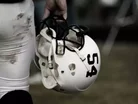13 Things You Need to Know About Concussions, Brain Damage and Sports

With the Super Bowl only a month and a half away, it’s time we discuss how dangerous football really is and what the effects of concussions are. Here are 13 things you need to know.
1. There are roughly 1.6 to 3.8 million concussions in the U.S. every year from professional and recreational sports.
2. Up to half of concussions go unreported.
3. Concussions reported in the NFL are on the rise, likely because of a reduced stigma in reporting them. Concussions reported per week increased 67 percent from 2009 to 2012.
4. There’s little evidence that current sports helmets for youth reduce the risk of concussions, according to a National Academy of Sciences report published last year.
5. The NFL agreed to pay $765 million to thousands of retired players for damages from concussion-related health problems as part of a 2013 settlement. However, on January 14, a federal judge rejected the settlement because she wasn’t convinced the amount was high enough to cover all of the injured players. By settling with the players, the league won’t have to disclose how early it knew that neurological damage is linked to concussions.
6. NFL revenue in 2012 was $9.5 billion.
7. Repeated head injury is a risk factor for Alzheimer’s disease and its signature beta-amyloid protein brain plaques.
8. When the brain is hit, microtubules that act like train tracks for proteins to shuttle back and forth can get broken, dropping the cargo, which potentially builds up as protein plaques.
9. The white matter that connects different regions of the brain seems especially vulnerable because the faster it’s stretched, the stiffer it gets.
10. Chronic traumatic encephalopathy (CTE), characterized by a loss of neurons and build-up of tau protein in the brain, is often found in those with a history of head trauma. It’s associated with memory loss, confusion, and depression and can only be diagnosed only after death.
11. Frequent suicides have led some experts to wonder whether underlying mental illness causes CTE or if head injury is causing both brain degeneration and mental illness. In a 2012 study, 34 out of 35 postmortem brain samples from former pro football players showed signs of CTE. Six of the athletes had most likely died of suicide.
12. Last year, brain scans of five living, retired NFL players found excessive tau protein in all of them, particularly in memory and emotion areas.
13. Football might not even be the worst offender. It has 0.2 concussions per 1,000 player-hours, compared to 0.4 for FIFA soccer, 1.5 for the NHL, and 13.2 for boxing.
Sourced from Popular Science.
- Vaccines, Dementia & Food: The Week's Top Healthcare StoriesMedical Devices & Pharma
- Stanford: A Shingles Vaccine Could Cut Dementia Risk by 20%Medical Devices & Pharma
- What Does Eli Lilly’s US$3bn Dutch Pharma Investment Mean?Procurement & Supply Chain
- Supplies & Scope 3: This Week's Top 5 Stories in HealthcareProcurement & Supply Chain



